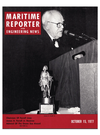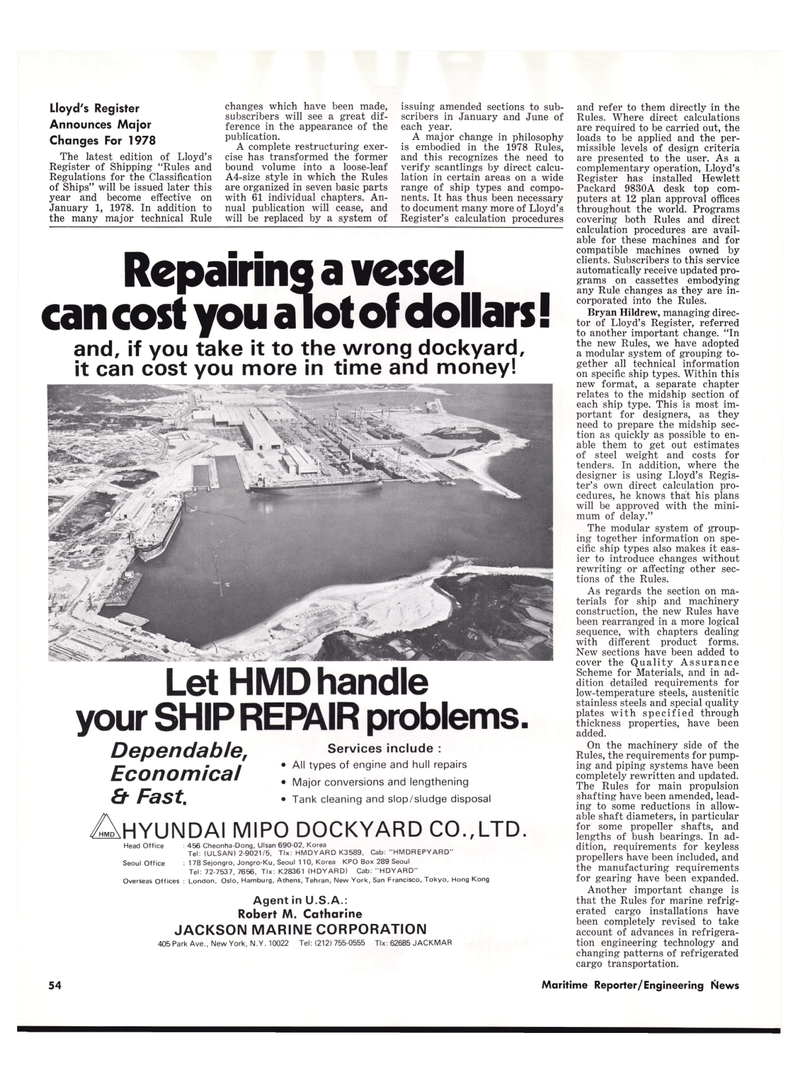
Page 50: of Maritime Reporter Magazine (October 15, 1977)
Read this page in Pdf, Flash or Html5 edition of October 15, 1977 Maritime Reporter Magazine
Lloyd's Register
Announces Major
Changes For 1978
The latest edition of Lloyd's
Register of Shipping "Rules and
Regulations for the Classification of Ships" will be issued later this year and become effective on
January 1, 1978. In addition to the many major technical Rule changes which have been made, subscribers will see a great dif- ference in the appearance of the publication.
A complete restructuring exer- cise has transformed the former bound volume into a loose-leaf
A4-size style in which the Rules are organized in seven basic parts with 61 individual chapters. An- nual publication will cease, and will be replaced by a system of issuing amended sections to sub- scribers in January and June of each year.
A major change in philosophy is embodied in the 1978 Rules, and this recognizes the need to verify scantlings by direct calcu- lation in certain areas on a wide range of ship types and compo- nents. It has thus been necessary to document many more of Lloyd's
Register's calculation procedures and refer to them directly in the
Rules. Where direct calculations are required to be carried out, the loads to be applied and the per- missible levels of design criteria are presented to the user. As a complementary operation, Lloyd's
Register has installed Hewlett
Packard 9830A desk top com- puters at 12 plan approval offices throughout the world. Programs covering both Rules and direct calculation procedures are avail- able for these machines and for compatible machines owned by clients. Subscribers to this service automatically receive updated pro- grams on cassettes embodying any Rule changes as they are in- corporated into the Rules.
Bryan Hildrew, managing direc- tor of Lloyd's Register, referred to another important change. "In the new Rules, we have adopted a modular system of grouping to- gether all technical information on specific ship types. Within this new format, a separate chapter relates to the midship section of each ship type. This is most im- portant for designers, as they need to prepare the midship sec- tion as quickly as possible to en- able them to get out estimates of steel weight and costs for tenders. In addition, where the designer is using Lloyd's Regis- ter's own direct calculation pro- cedures, he knows that his plans will be approved with the mini- mum of delay."
The modular system of group- ing together information on spe- cific ship types also makes it eas- ier to introduce changes without rewriting or affecting other sec- tions of the Rules.
As regards the section on ma- terials for ship and machinery construction, the new Rules have been rearranged in a more logical sequence, with chapters dealing with different product forms.
New sections have been added to cover the Quality Assurance
Scheme for Materials, and in ad- dition detailed requirements for low-temperature steels, austenitic stainless steels and special quality plates with specified through thickness properties, have been added.
Repairing a vessel can cost you alot of dollars! and, if you take it to the wrong dockyard, it can cost you more in time and money!
Let HMD handle your SHIP REPAIR problems
Dependable,
Economical
St Fast
Services include :
All types of engine and hull repairs
Major conversions and lengthening
Tank cleaning and slop/sludge disposal
HMD HYUNDAI MIPO DOCKYARD CO.,LTD
Head Office 456 Cheonha-Dong, Ulsan 690-02, Korea
Tel: (ULSAN) 2-9021/5, Tlx: HMDYARD K3589, Cab: "HMDREPYARD"
Seoul Office : 178 Sejongro, Jongro-Ku, Seoul 110, Korea KPO Box 289 Seoul
Tel: 72-7537,7656, Tlx: K28361 (HDVARD) Cab: "HDYARD"
Overseas Offices : London, Oslo, Hamburg, Athens, Tehran, New York, San Francisco, Tokyo. Hong Kong
Agent in U.S.A.:
Robert M. Catharine
JACKSON MARINE CORPORATION 405 Park Ave., New York, N.Y. 10022 Tel: (212) 755-0555 Tlx: 62685 JACKMAR 54
On the machinery side of the
Rules, the requirements for pump- ing and piping systems have been completely rewritten and updated.
The Rules for main propulsion shafting have been amended, lead- ing to some reductions in allow- able shaft diameters, in particular for some propeller shafts, and lengths of bush bearings. In ad- dition, requirements for keyless propellers have been included, and the manufacturing requirements for gearing have been expanded.
Another important change is that the Rules for marine refrig- erated cargo installations have been completely revised to take account of advances in refrigera- tion engineering technology and changing patterns of refrigerated cargo transportation.
Maritime Reporter/Engineering News

 49
49

 51
51
